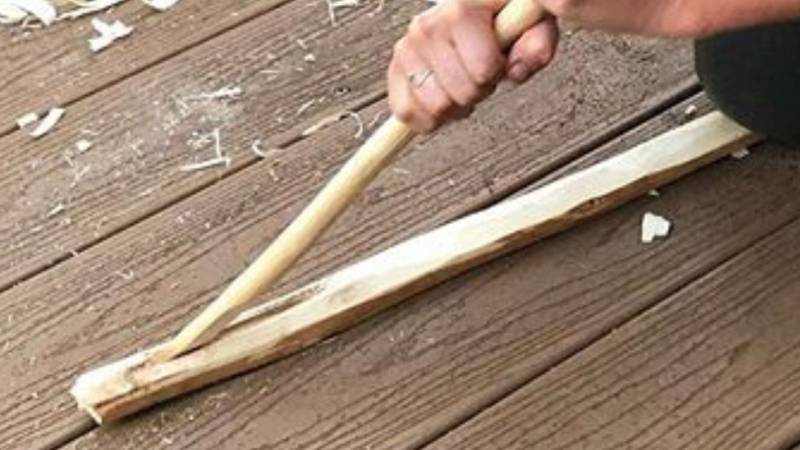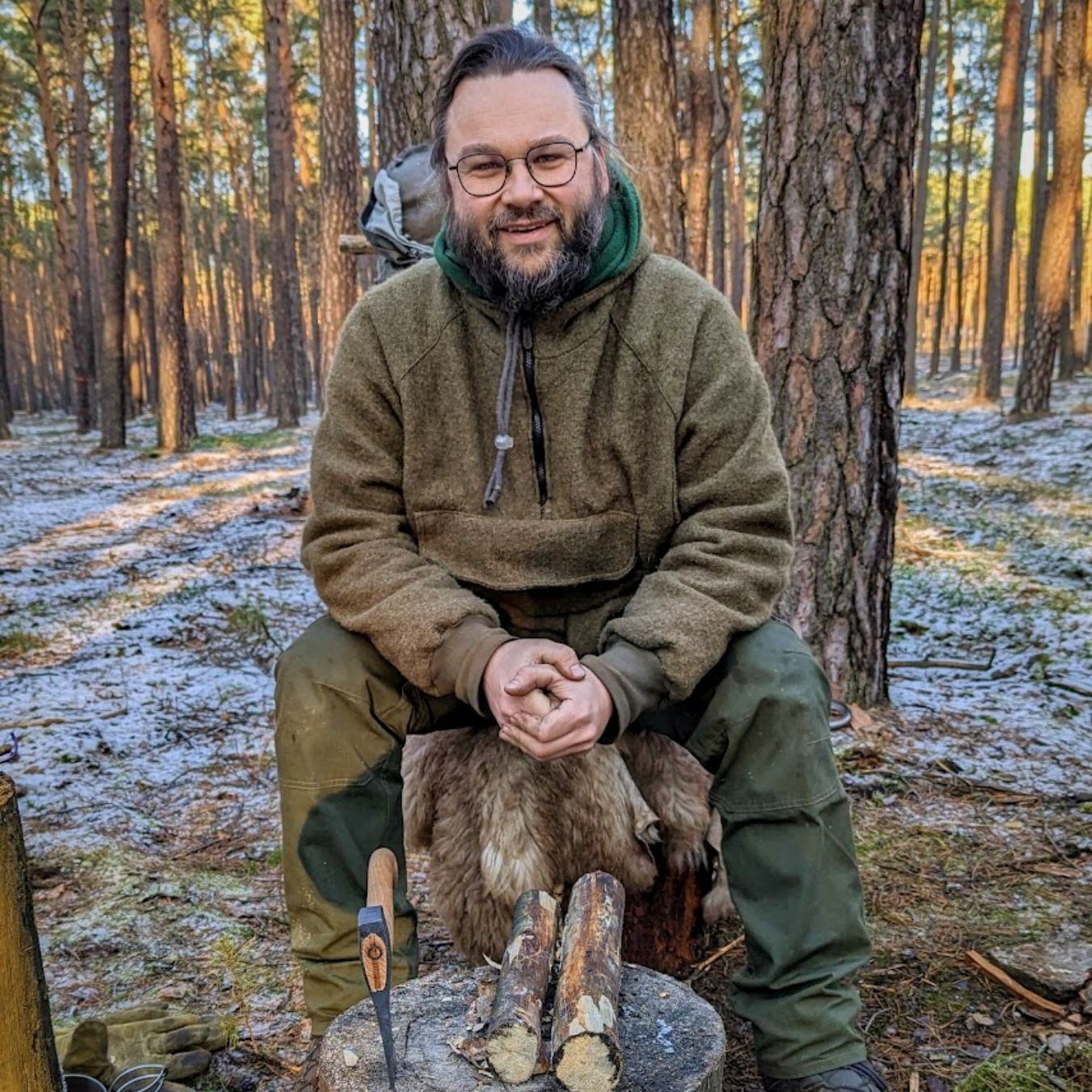
fire plow
Nomen
Meaning
The fire plow is a primitive fire-making technique used in survival, bushcraft, and wilderness skills. It involves using friction to create fire by rubbing a wooden plow against a wooden baseboard. The plow is typically made from a harder wood, while the baseboard is made from a softer wood. By applying downward pressure and rapidly moving the plow back and forth, the friction generates heat, eventually creating an ember that can be used to start a fire. The fire plow is a valuable skill to master in outdoor activities, as it provides a reliable method of fire-making without the need for modern tools or equipment.

Examples
„I love using the fire plow technique to start a fire in the wilderness. It's a primitive method that involves rubbing a wooden stick against a wooden base to create friction and generate heat.“
„The fire plow requires a lot of practice and patience to master, but once you get the technique right, it's a reliable way to ignite a fire without any modern tools.“
„When I was teaching my friend John how to use the fire plow, he struggled at first, but after a few attempts, he finally managed to create an ember and start a fire.“
„The fire plow is especially useful in damp or wet conditions when other fire-starting methods may fail.“
„I always carry a small wooden board and a stick with me when I go camping, just in case I need to use the fire plow to start a fire.“
Origin
The term "fire plow" originates from ancient fire-making techniques used by indigenous cultures around the world. It is believed to have originated in Southeast Asia and spread to other parts of the world, including Africa, the Americas, and the Pacific Islands.
The fire plow is a method of friction fire-starting, where a wooden plank or board is used to create friction against another piece of wood. The friction generates heat, which eventually ignites a small pile of tinder, creating fire.
This technique has been used for thousands of years and has been passed down through generations. It is a simple yet effective method of fire-making, especially in areas where other fire-starting tools may not be available.
Over time, the fire plow technique has been refined and adapted by different cultures, resulting in variations in the design and materials used. Some cultures use specific types of wood for the plow and baseboard, while others incorporate additional tools or techniques to enhance the effectiveness of the fire plow.
Today, the fire plow is still practiced by survivalists, bushcraft enthusiasts, and those interested in primitive skills. It serves as a reminder of our ancestors' resourcefulness and ingenuity in harnessing the power of fire for survival and everyday needs.
Synonyms
Fire drill, Fire bow, Fire saw, Fire friction, Fire starter, Fire making, Fire ignition, Fire kindling
Antonyms
Water, Extinguish, Put out, Dampen, Quench, Smother, Suppress, Suffocate
Relatives
Fire making, Friction fire, Fire starting, Fire bow drill, Fire piston, Fire steel, Fire tinder
Historical and cultural importance
The fire plow is a primitive fire-starting technique that has been used by various indigenous cultures around the world for thousands of years. It involves using friction to create heat and ignite tinder, eventually leading to the creation of fire. This method is particularly significant in the history of human survival, as it allowed early humans to harness the power of fire for warmth, cooking, protection, and other essential needs.
The fire plow is believed to have originated in Southeast Asia and spread to other parts of the world, including Africa, the Americas, and the Pacific Islands. Different cultures have developed their own variations of the fire plow, using different materials and techniques. For example, in Southeast Asia, a hardwood stick is rubbed against a softer wooden base, while in Africa, a pointed stick is rapidly pushed back and forth along a groove carved into a wooden board.
Mastering the fire plow requires skill, patience, and knowledge of the right materials to use. It is a testament to the resourcefulness and ingenuity of our ancestors, who relied on this technique to survive in harsh environments. Today, the fire plow is still practiced by survival enthusiasts and those interested in primitive skills, as it provides a hands-on experience of our ancient connection to fire and the natural world.
More information about the term fire plow
Fire Plow: Creating Fire with Friction
The fire plow is a primitive fire-making technique that has been used by indigenous cultures for centuries. It is a method of creating fire through friction, using a wooden plank and a stick. This technique requires skill, patience, and the right materials to be successful.
Materials Needed
To create a fire plow, you will need the following materials:
- A wooden plank: Choose a dry, flat piece of wood that is about one to two feet long and a few inches wide. Hardwoods like cedar or oak work best.
- A fire plow stick: This should be a harder wood than the plank, about one to two inches in diameter and about a foot long.
- Tinder: Gather dry, fine materials like grass, leaves, or bark to use as tinder to catch the ember.
Creating the Fire Plow
Follow these steps to create a fire plow:
- Prepare the plank: Smooth out one side of the plank by scraping it with a knife or a rock. This will create a smooth surface for the friction.
- Create a groove: Using the fire plow stick, press down firmly on the plank and move it back and forth to create a groove. The groove should be about half an inch wide and a few inches long.
- Collect tinder: Gather a small pile of dry, fine tinder materials and place them near the groove.
Using the Fire Plow
Now that you have prepared the fire plow, it's time to create fire:
- Position the fire plow: Place the fire plow stick at one end of the groove, with the other end resting on the ground.
- Apply pressure and friction: Press down firmly on the fire plow stick and start rubbing it back and forth along the groove. Apply consistent pressure and maintain a steady rhythm.
- Catch the ember: As you continue rubbing, the friction will create heat, eventually causing the wood to char. Keep rubbing until you see a small ember forming in the charred wood.
- Transfer the ember: Carefully transfer the ember onto the prepared tinder pile, gently blowing on it to encourage combustion.
- Nurture the flame: Once the tinder catches fire, carefully transfer it to your fire pit or shelter, adding larger pieces of wood to build a sustainable fire.
The fire plow technique requires practice and perseverance. It is important to choose the right materials and maintain a steady rhythm to generate enough heat for the ember to form. With time and experience, you will become proficient in this ancient fire-making method.
Back to overview

